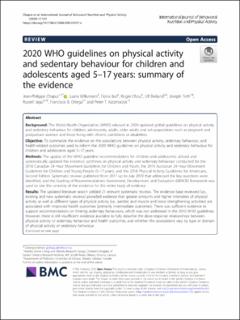| dc.contributor.author | Chaput, Jean-Philippe | |
| dc.contributor.author | Willumsen, Juana F. | |
| dc.contributor.author | Bull, Fiona | |
| dc.contributor.author | Chou, Roger | |
| dc.contributor.author | Ekelund, Ulf | |
| dc.contributor.author | Firth, Joseph | |
| dc.contributor.author | Jago, Russell | |
| dc.contributor.author | Ortega, Francisco B. | |
| dc.contributor.author | Katzmarzyk, Peter T. | |
| dc.date.accessioned | 2021-03-04T13:22:33Z | |
| dc.date.available | 2021-03-04T13:22:33Z | |
| dc.date.created | 2021-01-07T13:51:55Z | |
| dc.date.issued | 2020 | |
| dc.identifier.citation | International Journal of Behavioral Nutrition and Physical Activity. 2020, 17(2020), Artikkel 141. | en_US |
| dc.identifier.issn | 1479-5868 | |
| dc.identifier.uri | https://hdl.handle.net/11250/2731673 | |
| dc.description | This article is licensed under a Creative Commons Attribution 4.0 International License, which permits use, sharing, adaptation, distribution and reproduction in any medium or format, as long as you give appropriate credit to the original author(s) and the source, provide a link to the Creative Commons licence, and indicate if changes were made. The images or other third party material in this article are included in the article's Creative Commons licence, unless indicated otherwise in a credit line to the material. If material is not included in the article's Creative Commons licence and your intended use is not permitted by statutory regulation or exceeds the permitted use, you will need to obtain permission directly from the copyright holder. To view a copy of this licence, visit http://creativecommons.org/licenses/by/4.0/. The Creative Commons Public Domain Dedication waiver (http://creativecommons.org/publicdomain/zero/1.0/) applies to the data made available in this article, unless otherwise stated in a credit line to the data. | en_US |
| dc.description.abstract | Background: The World Health Organization (WHO) released in 2020 updated global guidelines on physical activity and sedentary behaviour for children, adolescents, adults, older adults and sub-populations such as pregnant and postpartum women and those living with chronic conditions or disabilities.
Objective: To summarize the evidence on the associations between physical activity, sedentary behaviour, and health-related outcomes used to inform the 2020 WHO guidelines on physical activity and sedentary behaviour for children and adolescents aged 5–17 years.
Methods: The update of the WHO guideline recommendations for children and adolescents utilized and systematically updated the evidence syntheses on physical activity and sedentary behaviour conducted for the 2016 Canadian 24-Hour Movement Guidelines for Children and Youth, the 2019 Australian 24-Hour Movement Guidelines for Children and Young People (5–17 years), and the 2018 Physical Activity Guidelines for Americans, Second Edition. Systematic reviews published from 2017 up to July 2019 that addressed the key questions were identified, and the Grading of Recommendations Assessment, Development and Evaluation (GRADE) framework was used to rate the certainty of the evidence for the entire body of evidence.
Results: The updated literature search yielded 21 relevant systematic reviews. The evidence base reviewed (i.e., existing and new systematic reviews) provided evidence that greater amounts and higher intensities of physical activity as well as different types of physical activity (i.e., aerobic and muscle and bone strengthening activities) are associated with improved health outcomes (primarily intermediate outcomes). There was sufficient evidence to support recommendations on limiting sedentary behaviours, which was not addressed in the 2010 WHO guidelines. However, there is still insufficient evidence available to fully describe the dose-response relationships between physical activity or sedentary behaviour and health outcomes, and whether the associations vary by type or domain of physical activity or sedentary behaviour.
Conclusions: Addressing the identified research gaps will better inform guideline recommendations in children and adolescents, and future work should aim to prioritize these areas of research. In the meantime, investment and leadership is needed to scale up known effective policies and programs aimed at increasing activity in children and adolescents. | en_US |
| dc.language.iso | eng | en_US |
| dc.subject | public health | en_US |
| dc.subject | recommendations | en_US |
| dc.subject | guidelines | en_US |
| dc.subject | physical activity | en_US |
| dc.subject | sedentary | en_US |
| dc.subject | exercise | en_US |
| dc.subject | policy | en_US |
| dc.subject | youth | en_US |
| dc.title | 2020 WHO guidelines on physical activity and sedentary behaviour for children and adolescents aged 5–17 years: Summary of the evidence | en_US |
| dc.type | Peer reviewed | en_US |
| dc.type | Journal article | en_US |
| dc.description.version | publishedVersion | en_US |
| dc.rights.holder | © The Author(s). 2020 | en_US |
| dc.source.pagenumber | 9 | en_US |
| dc.source.volume | 17 | en_US |
| dc.source.journal | International Journal of Behavioral Nutrition and Physical Activity | en_US |
| dc.source.issue | 2020 | en_US |
| dc.identifier.doi | 10.1186/s12966-020-01037-z | |
| dc.identifier.cristin | 1867088 | |
| dc.description.localcode | Institutt for idrettsmedisinske fag / Department of Sports Medicine | en_US |
| dc.source.articlenumber | 141 | en_US |
| cristin.ispublished | true | |
| cristin.fulltext | original | |
| cristin.fulltext | original | |
| cristin.qualitycode | 2 | |
